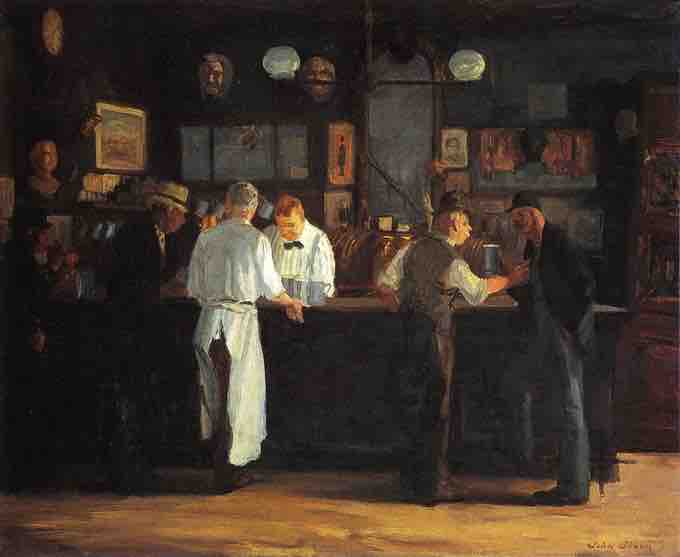Realism
From the late nineteenth to the early twentieth centuries, the United States experienced enormous industrial, economic, social, and cultural change. A continuous wave of European immigration and the rising potential for international trade brought increasing growth and prosperity to America. Through artistic expression, American realism attempted to portray the cultural exuberance of the figurative American landscape and the life of ordinary Americans at home. Artists allowed the emotional tenor, textures, and sounds of the city to influence the style and composition of their creative projects. Musicians noted the fast-paced nature of life in the early twentieth century and responded with a fresh and new tempo. Authors told new stories about boys and girls that real Americans could have grown up with. Pulling away from fantasy and focusing on the now, American realism presented a new gateway into modernism. The Ashcan School, also known as "The Eight," along with the group called "Ten American Painters," created the core of American modernism in the visual arts.
The Ashcan School
The Ashcan School was a group of New York City artists who sought to capture the feel of turn-of-the-century New York City through realistic portraits of everyday life. These artists not only depicted the rich and promising Fifth Avenue socialites, but also the culturally textured lives of the lower classes. At least one critic of the time did not like the Ashcan School's choice of subjects, which included alleys, tenements, slum dwellers, and taverns frequented by the working class. The group included members such as George Bellows, Robert Henri, Everett Shinn, George Benjamin Luks, William Glackens, John Sloan, and Edward Hopper, and became known as the "Revolutionary Black Gang" and the "Apostles of Ugliness."

McSorley's Bar (1912)
McSorley's Bar, John French Sloan, 1912 (oil on canvas).
Realist writers included Samuel Clemens (Mark Twain), Stephen Crane, William Dean Howells, and Horatio Alger Jr. Realist journalists, also called "muckrakers," included Jacob Riis and cartoonist Art Young. Realist musicians counted James Allen Bland, C.A. White, and Scott Joplin in their number.
Mark Twain
Samuel Clemens (1835–1910), better known by his pen name of "Mark Twain," grew up in the Mississippi River frontier town of Hannibal, Missouri. Early nineteenth-century American writing tended to be flowery, sentimental, or ostentatious—partially because authors were still trying to prove that they could write as elegantly as the English. Twain's style, however, was based on vigorous, realistic, colloquial American speech, and gave American writers a new appreciation of their national voice. Twain was the first major author to come from the interior of the country, and he captured its distinctive, humorous slang and tendency toward iconoclasm. For Twain and other American writers of the late nineteenth century, realism was not merely a literary technique: It was a way of speaking truth and exploding worn-out conventions. Twain is best known for his works Tom Sawyer and The Adventures of Huckleberry Finn, the latter of which combined rich humor, a sturdy narrative, and social criticism.
Literary Naturalism
Naturalism was a literary movement taking place from roughly 1880 to 1940 that used detailed realism to suggest that social conditions, heredity, and environment had an inevitable role in shaping human character. Naturalism is the outgrowth of literary realism, a prominent literary movement in mid-nineteenth century France and elsewhere. Naturalistic writers were influenced by Charles Darwin's theory of evolution. They believed that heredity and social environment largely determine one's character. Whereas realism seeks only to describe subjects as they really are, naturalism also attempts to determine the underlying forces (e.g., the environment or heredity) influencing the actions of its subjects. Naturalistic works often include uncouth or sordid subject matter; for example, the works of Émile Zola, the most renowned literary naturalist, demonstrate a frankness about sexuality along with a pervasive pessimism. Naturalistic works exposed life's dark, harsh realities, including poverty, racism, violence, prejudice, disease, corruption, prostitution, and filth. As a result, naturalistic writers frequently were criticized for focusing too much on human vice and misery.